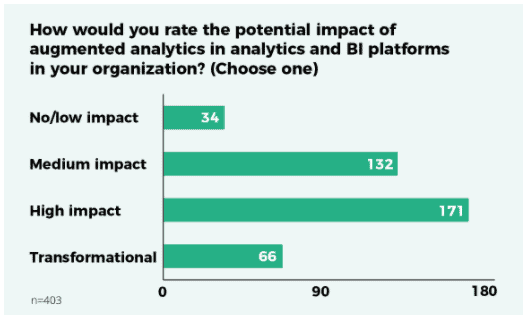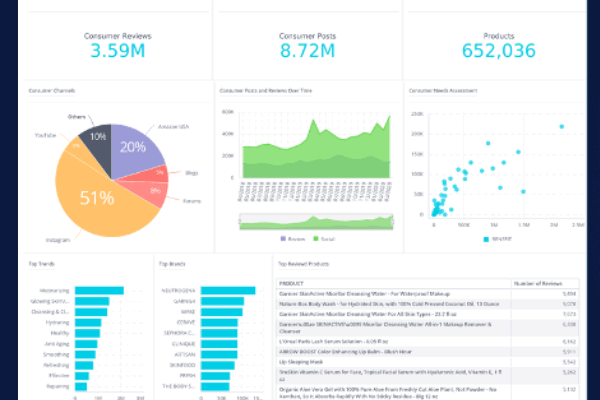For marketers, maximizing advertising ROI generally means optimizing programs by leveraging insights from their advertising performance datasets—like impressions, clicks, and conversions—and internal business data, such as from customer surveys and actual sales performance. But wIth new developments in artificial intelligence (AI) and natural language processing (NLP), the way marketers approach advertising and campaign strategy is changing dramatically.
Marketers today recognize that traditional tools and approaches are hampering their ability to be more strategic and that there are new opportunities to elevate the tactical and identify new opportunities to capture the growing audiences in e-commerce and social media and respond to shifting consumer needs. Increasingly, marketers recognize that to be competitive, they need to be much more in tune with their audience and meet them where they are, and to tie back that knowledge to marketing performance and overall business objectives.
Data needs context to be valuable
There is a disruption occurring with martech and adtech and it requires marketers to go deeper with analytics in order to reliably move the needle. To further complicate things, consumer privacy walls continue to go up, media platform data is becoming more opaque and consumers’ are not responding to old advertising tactics. The only way out is with contextual insights that tell the story behind the numbers, that surface trends, predictive insights, and real consumer sentiment in the context of what is happening in the overall market.
What does this mean exactly? What makes insights more contextually relevant to marketers? To start, they must be based on external data—diverse market trends about brand perception, consumer interests, and predictions for what’s around the corner—in addition to the direct feedback derived from day-to-day marketing activations.
Next, they need to be specific, surfacing real signals as opposed to noise, zeroing in on what is meaningful for the specific business or objectives at hand. And, of course, they need to be timely. This level of access and analysis capability requires augmentation from artificial intelligence and can help generate directional insights for marketers. As a honed organizational skill, it will empower them to better connect with customers, capitalize on upcoming opportunities, and provide a leg up on the competition within their category.
Many are already thinking this way. In a Gartner blog post earlier this year, more than 60% of respondents to a recent poll said they believe augmented analytics—those driven by artificial intelligence and machine learning—will have a high or transformational impact on their ability to scale the value of analytics in their organization.

“For example, a fast-food restaurant chain did not consider the location of more-profitable fountain drinks relative to bottle drinks. During a store remodel, the restaurant shifted the location of the fountain drinks and the augmented analytics system picked up a 20% increase in sales of fountain drinks and profitability — changing plans for future store design.” from Scale the Value of Analytics by Gartner.
To explore more about the potential for marketing insights, we spoke to co-founder and Chief Research Officer for Signals Analytics whose configurable advanced analytics platform enables organizations to fulfill data-driven objectives, by turning disconnected and disparate data sets into actionable intelligence, which in turn, drives sustainable growth.
Five Questions with Signals Analytics Chief Research Officer, Kobi Gershoni
What does Signals Analytics do?
Gershoni: Signals Analytics is an advanced analytics platform that leverages external data to surface trends and predictive insights. Leading fast-moving consumer goods (FMCG) and pharma manufacturers use Signals Analytics to determine strategic and tactical business decisions around product innovation, portfolio optimization, product positioning, and messaging. Companies leveraging the insights generated by the Signals Analytics platform experience faster time to insight, a longer shelf life for new products, fewer product changes post-launch, and sustainable growth outcomes.
Marketers use Signals Analytics to uncover trends and predictive insights that demystify marketing roadblocks in developing audience strategy, product positioning, performance benchmarks, channel and media mix, and relevant creative.
What are the data sources that Signals Analytics taps into?
Gershoni: We connect more than thirteen thousand external data sources, such as social media, e-commerce sites, news, blogs and forums (Facebook, Amazon, Walmart, newswires, etc.) and use patented NLP and machine learning capabilities to surface insights around the voice of the consumer, product claims and attributes, business updates and announcements, and other signals of marketplace innovation like patent filings. The Signals Analytics data lake is also able to ingest third-party-owned data sources like Nielsen, Informa, Brandwatch, IRIs, and others, as well as internal data sources.

These data sources are continually streamed into the data lake, which allows the insights to be generated on a timely basis.
Why are insights found outside of the advertising performance data set valuable to marketers?
Gershoni: To be successful in marketing today requires a constant, always-on approach that is in tune with consumer sentiments and desires. The problem is that standard marketing analytics provide only performance metrics (after the fact) without all of the qualitative inputs that are critical to impacting the success of marketing campaigns.
Some data platforms provide only the point of view of social listening, but there are many, many more data sources that when connected, provide a holistic picture of what is really happening in the market and how consumers are feeling about specific products or their desire for new products.
Having that information means:
- The ability to opportunistically optimize search or social campaigns towards specific keywords, imagery and messaging
- Understanding the differences in customers and trends between retailers and across marketing channels in order to position and price products most effectively by channel
- Insight about competitor initiatives, performance and brand health that guides realistic KPIs and benchmarking
- Deeper insight into the interplay of channels within and outside of your existing media mix and optimized ad budget allocations across channels
In other words: marketing that is based only on internal data is incomplete, and therefore always somewhat inefficient. But when you close the gap between your internal data and the right mix of external data, your marketing can be more visionary, based on more contextually relevant insights, and becomes a truly strategic function for your business.
What actually is a transformative insight? How does one define it and how does a marketer know one when they see it?
Gershoni: The difference between insights and transformative insights are threefold: actionability, impact potential, and the magnitude of change. First, the insight must lend itself to be actionable. There must be an opportunity for the marketer to actually implement some sort of next steps in order to benefit from it. If the insight is too outside of the box—or simply too complex or expensive—to execute, then it’s an interesting piece of information, but not transformative.
The impact potential too must be high for an insight to be truly valuable. If implementing the insight barely moves the needle, then it still could be a solid insight, but it won’t bring about the dynamic change that an organization desires. Finally, the magnitude of change must be considered. Does it pivot your company into a new direction or just validating something on the course you are already on? Transformative insights, by definition, should take your business scope into areas where you hadn’t explored before and open up new avenues for you to benefit.
No one really knows if an insight is going to be transformative until it is put into action and the results are measured. However, these are some of the shared traits that I’ve seen—in hindsight—in which insights have the most transformative effect.
How does a marketer apply a transformative insight to make it actionable and get the maximum impact?
Gershoni: That’s a tough question because every insight is unique and how you take action on it differs depending on so many variables. From my experience, the companies who have been able to successfully turn transformative insights into transformative results have been the ones that are able to commit the most to leverage the information to their benefit. Although methodical testing and learning is always a recommended course of action, it’s the marketers who decide to really pivot on the new information and make sweeping changes based on how they believe the insight should be best utilized that seem to reap the most reward. Big results require a big commitment.
It can be a bit nerve-racking to move into new areas and to place bets on new insights. However, if you truly believe that the insight offers real value, then the only way to capitalize on it is to use it to change the way that your organization views the world. That can be very uncomfortable because change is always hard, but that’s how I’ve seen insights-to-action work best.
Interested in learning more?
Skai’s suite of products helps marketers to not just manage and drive performance for their marketing programs, but it delivers the insights needed to make the best data-driven decision making.
Do your marketing platforms help you get to the next level?
To learn more about how recent innovations in artificial intelligence and machine learning can help your marketing program, contact us to set up a brief demonstration of our suite.







